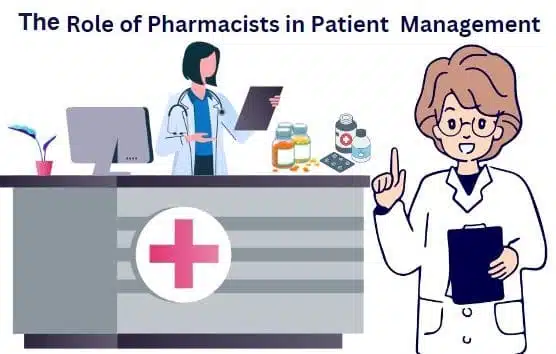Learn the role of pharmacists in patient management as outlined by the World Health Organization (WHO).
Table of Contents

Who is pharmacist?
A pharmacist is a healthcare professional responsible for preparing, dispensing, and advising on medications, ensuring their safe and effective use. They play a key role in patient care, collaborating with other healthcare providers to optimize treatment outcomes. According to the World Health Organization (WHO), pharmacists must have a minimum of a Bachelor’s degree in pharmacy (or its equivalent), followed by professional licensure. Many countries require additional postgraduate education or clinical training, and continuous professional development is encouraged to maintain competency in evolving pharmaceutical practices.
Rule of Pharmacists
Pharmacists play a crucial role in healthcare, particularly in patient management. The World Health Organization (WHO) has emphasized the significance of pharmacists as integral members of healthcare teams, promoting safe, effective, and rational use of medications. Their responsibilities extend beyond dispensing medicines; they are involved in various aspects of patient care, such as counseling, medication review, health promotion, and disease prevention.
1. Medication Management and Review
Pharmacists ensure that patients receive the right medications at the correct doses. This involves reviewing prescriptions for accuracy and appropriateness based on the patient’s medical history, current medications, and potential drug interactions. According to WHO, pharmacists must ensure rational medication use by reducing the risks of adverse drug reactions and medication errors.
Key Responsibilities:
Prescription Review: Verifying doses, indications, and possible interactions.
Monitoring Therapy: Checking if the prescribed medications achieve the desired therapeutic outcomes.
Preventing Medication Errors: Identifying and correcting errors, such as dosing issues or potential interactions between drugs.
Promoting Rational Drug Use: Ensuring that drugs are prescribed only when necessary and are appropriate for the condition being treated.
2. Patient Counseling
It is the duty of pharmacist to inform patients about the medications they use. Effective counseling helps ensure adherence to therapy and minimizes the risk of adverse effects. WHO highlights that patient education and counseling are crucial for improving health outcomes.
Key Responsibilities:
Medication Use Instructions: Explaining how to take medications, including the timing, dosage, and duration.
Side Effects and Precautions: Informing patients about possible side effects and what to do in case they experience them.
Lifestyle and Health Advice: Offering advice on lifestyle changes that complement the medication, such as dietary recommendations or exercise routines.
Follow-up and Monitoring: Encouraging patients to return for follow-ups to discuss any difficulties with their medications.
3. Public Health Promotion and Disease Prevention
Pharmacists are essential to the improvement of public health. The World Health Organization (WHO) recognizes pharmacists as key healthcare providers in educating communities, promoting vaccination, and encouraging preventive health measures. By providing accurate information on diseases and encouraging preventive behaviors, pharmacists contribute to the reduction of disease incidence and the promotion of overall community health.
Key Responsibilities:
Vaccination Programs: Many pharmacists administer vaccines and educate patients on their importance.
Health Screenings: Pharmacists often conduct screenings for conditions like hypertension, diabetes, or high cholesterol.
Health Education Campaigns: Pharmacists participate in health awareness campaigns about topics like smoking cessation, sexual health, and proper medication disposal.
4. Collaborative Care and Teamwork
Pharmacists work alongside physicians, nurses, and other healthcare providers to optimize patient care. WHO emphasizes that pharmacists’ collaboration with other healthcare professionals is essential for ensuring comprehensive and integrated care, particularly in managing chronic diseases such as diabetes or hypertension.
Key Responsibilities:
Inter professional Collaboration: Working with doctors and nurses to develop treatment plans and modify therapies based on patient progress.
Chronic Disease Management: Pharmacists help manage chronic conditions by ensuring that patients adhere to their prescribed medication regimens and by monitoring the efficacy of these treatments.
Medication Reconciliation: Pharmacists play a key role in medication reconciliation, particularly when patients transition between healthcare settings (e.g., hospital discharge), to ensure continuity and safety in their treatment.
5. Pharmacovigilance
Pharmacovigilance involves monitoring the safety of medications once they are in use. WHO stresses the importance of this practice in identifying, assessing, and preventing adverse effects or any other drug-related problems.
Key Responsibilities:
Monitoring Adverse Drug Reactions: Identifying, documenting, and reporting any side effects experienced by patients.
Patient Safety: Ensuring that medications prescribed are safe for individual patients based on their health conditions and other medications they may be taking.
Reporting: Pharmacists are often required to report adverse drug reactions to local or national Pharmacovigilance centers, contributing to the global monitoring of drug safety.
6. Antimicrobial Stewardship
Pharmacists are central to the efforts to combat antimicrobial resistance, which is a global health priority identified by WHO. Through antimicrobial stewardship programs, pharmacists help to ensure that antibiotics and other antimicrobial agents are used appropriately to minimize resistance development.
Key Responsibilities:
Ensuring Appropriate Use of Antibiotics: Ensuring that antibiotics are prescribed only when necessary and that the appropriate antibiotic, dose, and duration are selected.
Educating Patients: Explaining the importance of completing antibiotic courses and the dangers of misuse.
Collaborating with Physicians: Advising on alternative treatments when antibiotics are not required.
Conclusion
Pharmacists are essential contributors to patient care management and play a multifaceted role in healthcare, as recognized by WHO guidelines. From ensuring the safe dispensing of medications to managing therapeutic outcomes and participating in public health initiatives, pharmacists are pivotal in enhancing the quality of care those patients receive. Their expertise in pharmacotherapy, coupled with their accessibility as healthcare professionals, positions them to be key players in improving global health outcomes. As healthcare becomes more complex, the expertise of pharmacists in optimizing medication therapy and supporting patients in managing their health will continue to be essential.
WHO References:
The World Health Organization (WHO). The Role of the Pharmacist in the Health Care System. Geneva: WHO; 1994.
The World Health Organization (WHO). Rational Use of Medicines. WHO Policy Perspectives on Medicines. Geneva: WHO; 2002.
The World Health Organization (WHO). Global action plan on antimicrobial resistance. Geneva: WHO; 2015.
Frequently Asked Questions (FAQs)
Who is pharmacist?
A pharmacist is a healthcare professional responsible for preparing, dispensing, and advising on medications, ensuring their safe and effective use. They play a key role in patient care, collaborating with other healthcare providers to optimize treatment outcomes. According to the World Health Organization (WHO), pharmacists must have a minimum of a Bachelor’s degree in pharmacy (or its equivalent), followed by professional licensure. Many countries require additional postgraduate education or clinical training, and continuous professional development is encouraged to maintain competency in evolving pharmaceutical practices.

Abdus Sobhan Salim is professional experienced pharmacist in pharmaceuticals, author and founder of pharmabossbd.com, the first Bangladeshi pharmaceutical blogger since 2019.



